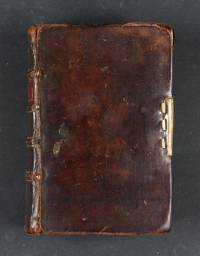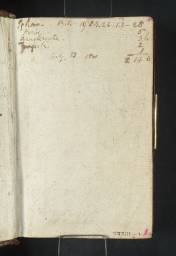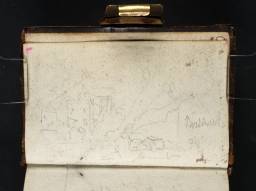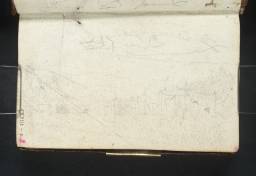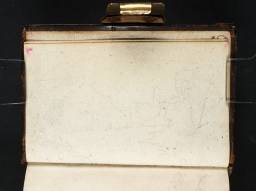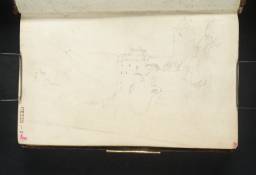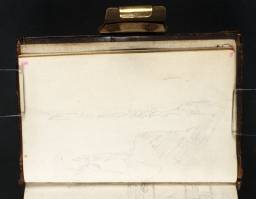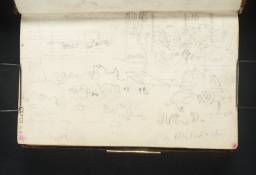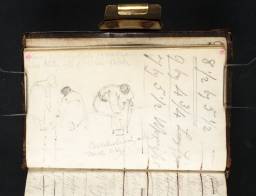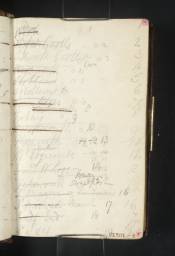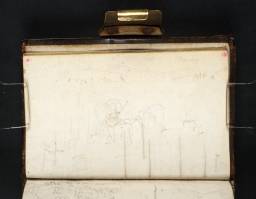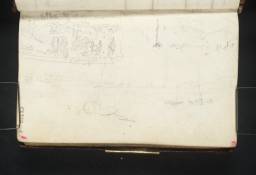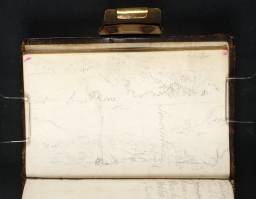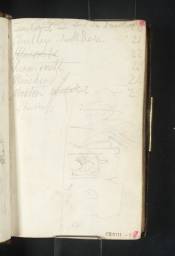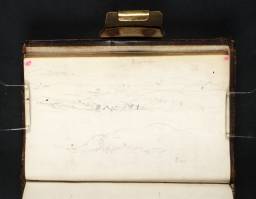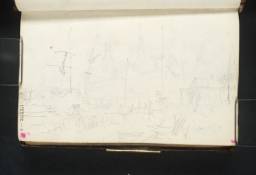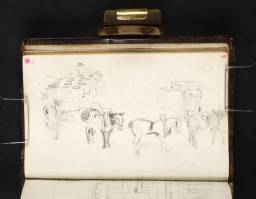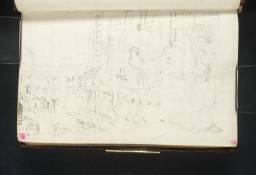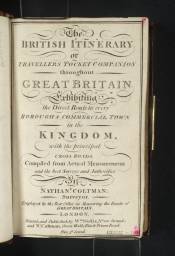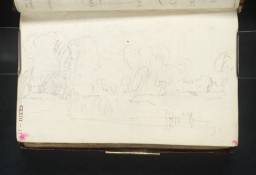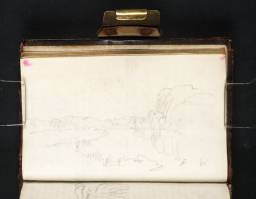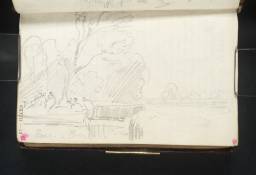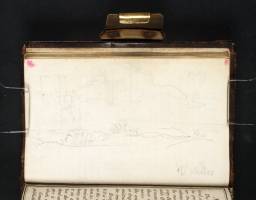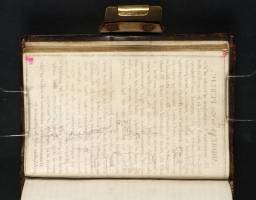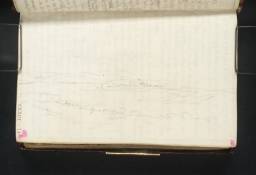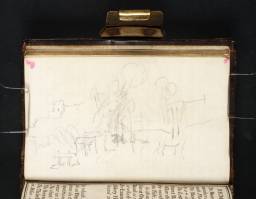Turner Bequest CXXIII 1–250
Interleaved copy of Nathaniel Coltman’s The British Itinerary (London, circa 1810) bound in boards, covered in brown leather with gilt rules to four raised bands on the spine, alternating solid and broken diagonal gilt hatching to all edges of the boards and one brass clasp with stamped zigzag motif
253 leaves of alternating white wove printing paper and white wove writing paper, with white laid paper endpapers (two free leaves and a paste-down at each end), Imperial 32mo, page size 117 x 75 mm
Makers unidentified; various leaves watermarked ‘W Dickie’ (printing paper), ‘Smyth | 1796’ and ‘1798’ or ‘17 8’ (endpapers); published by William Dickie and the author, London; for transcription of title page, see under folio 10 recto (D08380)
Stamped in gold ‘BRITISH | ITENARY’ [sic] on a red leather label on the spine, and inscribed by Turner in ink ‘Devonshire Coast | 1’ on the front cover (D40902)
Numbered 369 as part of the Turner Schedule in 1854 and endorsed by the Executors of the Turner Bequest, inside front cover (D40903)
253 leaves of alternating white wove printing paper and white wove writing paper, with white laid paper endpapers (two free leaves and a paste-down at each end), Imperial 32mo, page size 117 x 75 mm
Makers unidentified; various leaves watermarked ‘W Dickie’ (printing paper), ‘Smyth | 1796’ and ‘1798’ or ‘17 8’ (endpapers); published by William Dickie and the author, London; for transcription of title page, see under folio 10 recto (D08380)
Stamped in gold ‘BRITISH | ITENARY’ [sic] on a red leather label on the spine, and inscribed by Turner in ink ‘Devonshire Coast | 1’ on the front cover (D40902)
Numbered 369 as part of the Turner Schedule in 1854 and endorsed by the Executors of the Turner Bequest, inside front cover (D40903)
Accepted by the nation as part of the Turner Bequest 1856
Exhibition history
References
This small sketchbook is the cornerstone of Turner’s work in the West Country in the summer of 1811, primarily undertaken as research for his Picturesque Views on the Southern Coast of England watercolours (see the introduction to the tour). It includes a few sketches made on the route out of London through familiar scenes in the Thames Valley, followed by the main body of the tour, covering new ground south-westwards along the coasts of Dorset, Devon and Cornwall from Christchurch as far as the Falmouth area. On this outward leg of the journey Turner supplemented the thumbnail views here with more detailed drawings in the larger Corfe to Dartmouth and Ivy Bridge to Penzance sketchbooks (Tate; Turner Bequest CXXIV, CXXV).
Turner barely used the present book through the rest of Cornwall, which is recorded in detail in the Ivy Bridge book and on the sheets now known as the Cornwall and Devon sketchbook (Tate; Turner Bequest CXXV a). He took it out again when heading back eastwards through North Devon and Somerset, and at Stonehenge and Basingstoke towards the end of the tour, making more detailed studies concurrently in the Somerset and North Devon sketchbook and on the sheets now known as the Stonehenge sketchbook (Tate; Turner Bequest CXXVI, CXXV b). Despite Turner’s many larger sketches of likely subjects for the Southern Coast series, several of the resulting watercolours were based on the slight drawings in the present book alone – for example, Poole, Dorsetshire, taken from folio 14 recto (D08387; see the concordance for the whole series in the introduction to the 1811 tour). His visual recall was such that he was able to use the rapid ‘shorthand’ of these drawings as a sufficient aide-mémoire for complex compositions.
Interspersed with the drawings and printed text of the British Itinerary (see the technical notes below), sixty-nine pages are given over wholly or partly to ‘historical-cum-philosophical’1 verses in rhyming couplets of iambic pentameter, usually with about ten or twelve lines to the page, which Turner appears to have intended as his own commentary for publication in the Southern Coast. The first lines are on folio 18 verso (D08396), and the last on folio 207 verso (D08736; CXXIII 204a). As James Hamilton notes, they comprise ‘the longest and most sustained piece of writing Turner ever did’, showing ‘the first Calibanic stirrings of Turner the historian’.2 John Gage has characterised the poetry as ‘Thomsonian historical tableaux and moral allusions’,3 in reference to the poet James Thomson (1700–1748), whom Turner often quoted and imitated,4 and ‘no less than a commentary on the political and moral state of this bulwark of the nation at the height of the struggle against Napoleon’.5
Finberg observed6 that Thornbury had arbitrarily published much of the poem in his pioneering biography of Turner, without explanation, comprehension or sympathy.7 Having previously described them as ‘quite hopeless’,8 Finberg partly excused the uneven quality of the verses owing to their being ‘written currente calamo, in odd moments during a long journey’.9 Taking his cue from his reading of the opening pages of the poem, Jack Lindsay imagined that Turner ‘invoked Thomson to aid him “throughout the lingering night’s career”, so it seems that at night he meditated over the day’s events for which incidents would best go into verses written “by Nature’s hands”’10 (see folio 21 recto; D08401). Andrew Wilton has described the verses as ‘historical and moral reflections gathered together roughly according to the incidents of the road’.11
However, Hamilton has asserted that Turner actually wrote the poem before setting out on the tour, since ‘the lines of many of the pencil drawings made on adjacent blank leaves during the outward journey run on top of the spots where the ink has blotted’,12 and that it was based on his preparatory reading. The physical evidence alone is inconclusive, given the passage of time and the general condition of the sketchbook; there is much offsetting from the ink of Turner’s verses onto the opposite pages often occupied by his sketches, as described in individual entries, but this may be in part owing to subsequent exposure to damp or water. It is very difficult to assess whether the pencil work overlies the offset ink, or vice versa, although the lines on folio 155 recto (D08652; CXXIII 152) appear to have been written directly over an existing pencil landscape sketch. Turner’s sometimes vivid turns of phrase and imagery lift the writing out of the conventionalities of his usual Thomsonian mode and suggest a direct response to the landscapes, towns and people he encountered.
Kathleen Nicholson has observed: ‘No single thought is sustained for more than a dozen lines, and there is a great deal of mental meandering.’13 Gage has called the verses ‘very difficult and unpolished’ despite their ambition.14 While praising the verses’ ‘warm-hearted sympathy with the common people’, Finberg suggested it was ‘not worth the space and the toil’ to publish them in full.15 Nevertheless, he characterised the associated sketches as ‘the kind of notes that a poet would take’.16 Lindsay published a selective version17 and the lines have been transcribed in full by Rosalind Mallord Turner;18 these versions provide the basis for the readings in the present catalogue.
Lindsay was the first to suggest that Turner intended to publish the poem in some form, but inferred that either ‘his interest failed’ or a self-censoring ‘sense of failure’ intervened.19 The circumstances of Turner’s submission of the verses to Cooke and their unsympathetic reception have since been reconstructed, initially by John Gage, who made the connection with previously published correspondence between Turner and W.B. Cooke and between Cooke and his Southern Coast editor, the prolific historian and satirical poet William Combe (1742–1823).20 Combe was well-versed in this type of publication,21 and had taken responsibility after the writer and engraver John Landseer (1763/9–1852) had turned the project down.22 Whether Turner simply handed over the present sketchbook is unclear, but this seems very unlikely; the lines were probably written out again or revised in some more conventional format. Even so, Combe wrote to Cooke:
I am really concerned to be obliged to say that Mr. T–’s account is the most extraordinary composition I have ever read. It is impossible for me to correct it, for in some parts I do not understand it. ... In my private opinion, it is scarcely an admissible article in its present state23
Combe acknowledged Cooke’s subsequent request that he work without ‘a syllable’ of Turner’s text.24 In connection with passages relating to Poole and St Michael’s Mount – see Turner’s drafts beginning at folios 50 verso (D08458; CXXIII 50a) and 135 verso (D08619; CXXIII 132a) respectively) – Combe agreed but suggested that ‘if you do not mean to drive Mr. T– stark, staring mad, you had better get two uncorrected sheets’ to show him.25 This exchange was presumably prompted by Turner’s letter to Cooke of 16 December 1813, demanding all or nothing in terms of authorship:
I feel the necessity of requesting you will, under the peculiar case in which the MSS of St Michael and Poole are placed, desire Mr Coombe [sic] to deviate wholly from them; and if he has introduced anything which seems approximate, to be so good as to remove the same, as any likeness in the descriptions (though highly complimentary to my endeavours) must compel me to claim them ... as I shall not change [or ‘charge’?] or will receive any remuneration whatever for them, they are consequently at my disposal, and ultimately subject only to my use
In any case, as Gage, has observed the elements of wartime ‘patriotic commentary’ in Turner’s verses would soon have seemed out of date after the defeat of Napoleon in 1815,28 although the ‘poem amplifies the meaning of his images as did “The Fallacies of Hope”’ which he would later compose as ad hoc captions for exhibited works, ‘by alluding directly to a human dimension’.29
Thornbury 1862, vol.II, pp.16–32, and 1897, pp.205–19; references for relevant passages are given here in individual entries.
Hamilton 1997, p.143; see also Hamilton 2003, p.99, and in Hamilton, Nicola Moorby, Christopher Baker and others, Turner & Italy, exhibition catalogue, National Galleries of Scotland, Edinburgh 2009, p.31.
See Vincent Carretta, ‘Combe, William (1742–1823)’, <i>Oxford Dictionary of National Biography, accessed 4 June 2009 <i><.
Undated letter, quoted in Thornbury 1862, I, p.405 and 1897, pp.189–90; cited in Gage 1969, p.257 note 35, and quoted in Gage 1980, pp.55–6 note 3.
Undated letter, quoted in Thornbury 1862, I, p.406 and 1897, p.190; cited in Gage 1969, p.257 note 35.
Technical notes
How to cite
Matthew Imms, ‘Devonshire Coast, No.1 sketchbook 1811’, sketchbook, June 2011, in David Blayney Brown (ed.), J.M.W. Turner: Sketchbooks, Drawings and Watercolours, Tate Research Publication, December 2012, https://www

